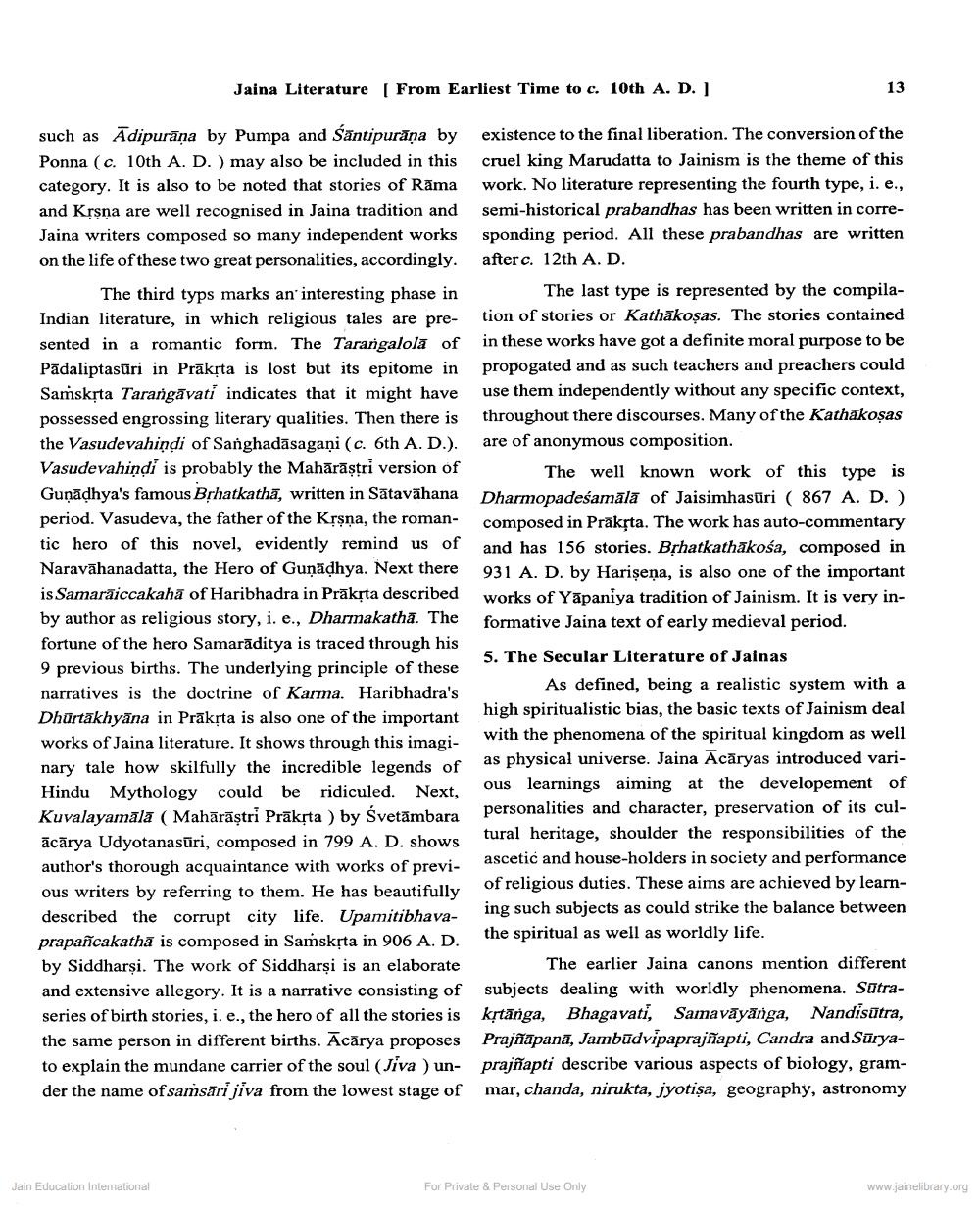________________
Jaina Literature (From Earliest Time to c. 10th A. D. ]
such as Adipurāņa by Pumpa and Santipurāņa by existence to the final liberation. The conversion of the Ponna (c. 10th A. D. ) may also be included in this cruel king Marudatta to Jainism is the theme of this category. It is also to be noted that stories of Rāma work. No literature representing the fourth type, i.e., and Krşņa are well recognised in Jaina tradition and semi-historical prabandhas has been written in correJaina writers composed so many independent works sponding period. All these prabandhas are written on the life of these two great personalities, accordingly. after c. 12th A. D. The third typs marks an interesting phase in
The last type is represented by the compilaIndian literature, in which religious tales are pre- tion of stories or Kathakosas. The stories contained sented in a romantic form. The Tarangalola of in these works have got a definite moral purpose to be Padaliptasuri in Prākrta is lost but its epitome in propogated and as such teachers and preachers could Samsksta Tarangāvati indicates that it might have use them independently without any specific context, possessed engrossing literary qualities. Then there is throughout there discourses. Many of the Kathakosas the Vasudevahindi of Sanghadāsagani (c. 6th A. D.). are of anonymous composition. Vasudevahindi is probably the Mahārāştri version of
the well known work of this type is Gunadhya's famous Brhatkatha, written in Sātavāhana Dharmopadeśamala of Jaisimhastri ( 867 A. D. ) period. Vasudeva, the father of the Krşna, the roman
composed in Praksta. The work has auto-commentary tic hero of this novel, evidently remind us of and has 156 stories. Brhatkathākośa, composed in Naravāhanadatta, the Hero of Gunadhya. Next there 931 A. D. by Harişeņa, is also one of the important is Samaräiccakahā of Haribhadra in Prākta described works of Yapaniya tradition of Jainism. It is very inby author as religious story, i. e., Dharmakatha. The formative Jaina text of early medieval period. fortune of the hero Samarāditya is traced through his
5. The Secular Literature of Jainas 9 previous births. The underlying principle of these narratives is the doctrine of Karma. Haribhadra's
As defined, being a realistic system with a Dhurtākhyāna in Prāksta is also one of the important
portant high spiritualistic bias, the basic texts of Jainism deal
en sp works of Jaina literature. It shows through this imagi
with the phenomena of the spiritual kingdom as well nary tale how skilfully the incredible legends of as physical universe. Jaina Acāryas introduced variHindu Mythology could be ridiculed. Next,
ous learnings aiming at the developement of Kuvalayamala ( Mahārāștri Prākrta ) by svetāmbara
personalities and character, preservation of its culācārya Udyotanasūri, composed in 799 A. D. shows
tural heritage, shoulder the responsibilities of the author's thorough acquaintance with works of previ
ascetic and house-holders in society and performance ous writers by referring to them. He has beautifully
of religious duties. These aims are achieved by learndescribed the corrupt city life. Upamitibhava
ing such subjects as could strike the balance between prapañcakatha is composed in Samskrta in 906 A.D. the spiritual as well as worldly life. by Siddharşi. The work of Siddharşi is an elaborate The earlier Jaina canons mention different and extensive allegory. It is a narrative consisting of subjects dealing with worldly phenomena. Satraseries of birth stories, i. e., the hero of all the stories is kệtānga, Bhagavati, Samavāyanga, Nandisūtra, the same person in different births. Ācārya proposes Prajñāpanā, Jambūdvipaprajñapti, Candra and Sūryato explain the mundane carrier of the soul (Jiva ) un- prajñapti describe various aspects of biology, gramder the name of samsāri jiva from the lowest stage of mar, chanda, nirukta, jyotisa, geography, astronomy
Jain Education International
For Private & Personal Use Only
www.jainelibrary.org




